Pearce and Fanaticism
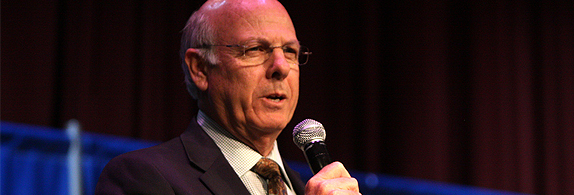
Fanaticism is “redoubling your effort after you have forgotten your aim.”
That’s what Hispanic-American philosopher George Santayana wrote in his l905 book The Life of Reason.
Fanatics are a variable lot. Some throw bombs and hope they’re sending a message. But what kind of message is a murder? Some shut down governments and leave millions of people stranded, their life savings in jeopardy, their country on the ropes for reasons no one, not even they, can fathom. They must be trying to convince somebody of something, but like the bomber all they’re doing is making people furious.
Fanatics in the House of Representatives have chosen allegiance to their measly political party over allegiance to their nation and fellow citizens. That is fanaticism at work in a very nasty way.
Their hatred of the President, and of our long history of caring for those who can’t help themselves, is so bitter and petulant, they seriously are threatening to undermine our government, our Constitution, our economy, and our standing in the world.
I won’t go so far as to call their shutdown of the government and potential default on the good faith and credit of the United States an act of treason, but if Democrats were doing this you know that’s what the rabid right would say. The Tea Party House has not only lost sight of their purpose as members of Congress, they’re missing any semblance of what it means to be an American citizen.
That’s my reading of what a majority of New Mexican’s think about the Tea Party House and its lone New Mexico adherent – Steve Pearce from District Two in southern New Mexico.
Serving as one of three Congresspersons from the poorest state in the nation, Pearce voted to turn off the faucet of the one great source of economic plenty New Mexico has secured for itself, federal jobs. It’s unbelievable. Not only is he trying to defund the Affordable Care Act, something that the poor of his state desperately need, but he’s then quoted as saying he’d support reopening the government, without anti-Obamacare provisos, as long as Congresspersons and their staffs don’t get special treatment. Special treatment? Does he mean that he supports Congress not getting paid as long as the shutdown holds? Does it mean Congress will get a dock in pay? Baloney.
Not only do the Tea Partiers blame the President for shutting the national parks and monuments, when they voted to shut down the government, they’re now running huge ads saying that the President is to blame for everything, as if he has the “power of the purse strings,” which is the House’s greatest power.
What worries me right now is the Kirtland Air Force Base jet fuel spill clean up. It’s hard to get information on exactly who’s been “furloughed” and who’s being paid, but a random sampling of contractors having to do with the non-combat functions of the military sent their workers home last week.
Tea Party politics in the House could end up crippling New Mexico’s economy and compromising the clean up of toxic waste in our water supply. And to what end? What is the aim they keep redoubling their efforts to achieve? The ruination of us all? And why is a New Mexico congressman, representing the most impoverished place in the country, even talking with those yahoos? It has to be that he has chosen party politics over the public interest. Or is it really just a matter of venal politics? Is it that the Koch Brothers, through the Tea Party, have threatened to “primary” him? Is he afraid he’ll lose his job? Is he more bound to the power bought by the wealth of the Kochs than he is to his country and his oath to uphold the Constitution?
Weeds After the Rains
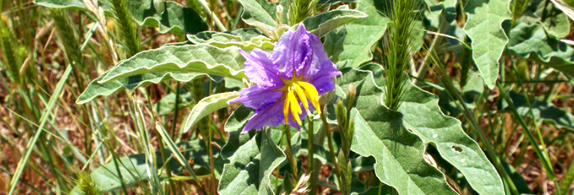
The only good thing I can think of about our drought is that it brings the reassuring visage of a weedless back forty. No worries about forests of desiccated stems turning the landscape behind our house into a 4th of July fire hazard. Just barren dirt, rocks, and dried snail shells.
Ah, but then the rains. And then the weeds, and then our back acre [pun intended] becomes the greatest gym in the city. For older folks who walk a lot but have stiff joints, there’s nothing like a daily workout in the garden, and after a huge rain, that workout can become a prelude to chiropractic.
In our backfield it’s the kochia, the goatheads [or puncture vines], the unearthly forests of pigweed, the tumbleweeds with the wild itching they can cause, the yellow flowered London Rockets [wild mustard] and the silver leaf nightshade with its beautiful purple blossoms, Christmas ball seeds, and tiny, nettle-like thorns along the stems
Kochia, the bane of the North Valley, apparently is grown in some places as an ornamental plant because some varieties of it turn deep red in the Fall. But I’d classify it like the City does when it describes weeds as “all rank, noxious, poisonous, harmful, unhealthful vegetation, deleterious to health.” Dead kochia is an urban fire hazard, worse even than pigweed, in my judgment. An acre of the dry, pine-shaped kochia skeletons could probably burn down a neighborhood given enough wind and the proximity of houses. It was introduced into North America from Eurasia to help control soil erosion.
But kochia, apparently, also has medicinal properties. We’ve come to called it Navajo Pimple Weed from a story we got from a doc serving in the Indian Health Service years ago out in Tuba City, Arizona. If you say the right words in Navajo, and pull a green kochia plant out of the ground in the ritually prescribed manner, it becomes an effective anti-acne medication. Chinese traditional medicine uses kochia seeds to help with hypertension and atherosclerosis.
And who knew that baby tumbleweeds, or Russian Thistle, imported into South Dakota in the l870s in a shipment of flax seeds from Russia, if steamed and covered in butter make a fine side vegetable, all be it with an “interesting” texture. Or that Silver Night Shade is toxic to livestock but, if combined with brains, can be used to tan leather.
Goat heads can be eradicated from parts of your garden. I know it’s true. I’ve done it myself. But the darn things always find their way back. And no matter if you call them puncture vine, or the devil’s eyelashes, or tackweed, one of their seeds in any part of your anatomy hurts like the devil’s thorn, which is another name for them. But of course, folks have found a use for them. The chemicals in the seeds have well-researched aphrodisiac qualities and can be used to cure erectile dysfunction. It’s apparently a plant that exists worldwide. There’s no escaping it.
If one can have a favorite weed, mine’s the London Rocket, or wild mustard. It’s my favorite, at least until the rains hit it at just the right moment as they did in 2005. A brief blast of water at the genetically pregnant instant in the spring, and the Rocket’s leafy greens and yellow flowers literally overwhelmed our whole patch of land. There was so much of the stuff, the whole city had front lawns full of it. The whole place looked like a salad. It gets its name from turning London very leafy green after the Great Fire of l666. And wouldn’t you know it, certain Arab tribes use it as a alternative to tobacco.
Toadhouse aka Allan Graham aka Skip
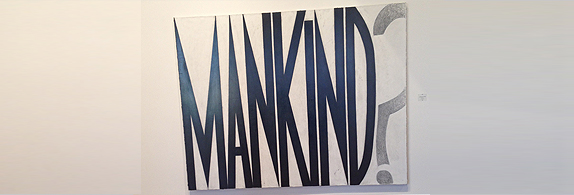
If the universe didn’t have humor in it, if the comic and the unexpected weren’t the children of consciousness, if the language of puns and jokes and the clarity of happiness weren’t properties of atoms too, then one might actually have a reason to give up on space/time and the human species and settle into a stupor until the escape of death opened the way for some peace and quiet.
But a poet named Toadhouse, and a painter named Allan Graham, and my old friend of almost five decades Skip Graham – all of whom share the same DNA, and are identical, save for their avatars – turned 70 last week on the stage set of the David Richard Gallery in the Railyard Arts District of Santa Fe and that made me happy, and the work in that clean, handsome space took me serenely into itself which proved to be exactly where, at the moment, I wanted to be.
While description always refers only to itself, I’d have to describe Skip’s work as having, for me, a long history of opening doors and climbing steps into consciousness without self-importance. It’s hard for me to have much more to say than that because by breaking down the borders between lexical space and visual space – I’m beginning to sound like an art critic, and I’m surely not – crossing the boundaries of word things and image things, a freedom is let loose, at times even a giddiness. And of all the truths we experience, the truth of the unpremeditated smile is the most convincing and believable.
As Toadhouse has written:
mystery
holds
true
And more to the point:
thought
should only
be
referred
to
So one might actually see for themselves in a painting the title of which is:
“is forming in a was universe.”
Toadhouse paints this poem:
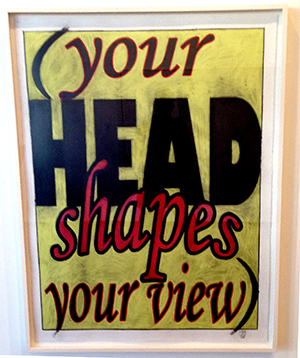
Next to it is a red painting which reads “now! the future at a reduced distance.” It is arranged on the canvas in a way that causes the mind to jumble around in its own synaptic distances.
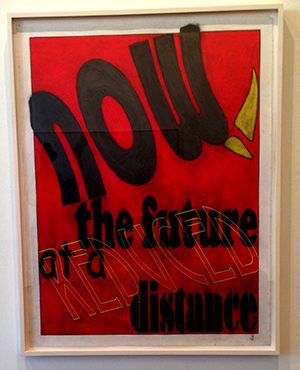
And another Toadhouse poem reads “Any Position Limits the View (We Are Only Here For A Spell). “
My two favorite works in the Birthday Exhibition are, first, a large painting in which Toadhouse, with black and white surfaces laid down as if they had been polished by a glacier, writes: MANKIND?
And then in an upstairs space one finds a graphite colored painting/drawing which in entitled “Chance Forming on the Edge of Need” in which a comet of chance is rushing at a continent of need.
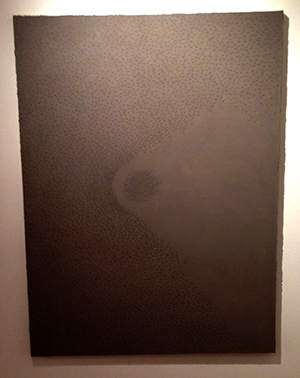
Also in the David Richard Gallery is Gloria and Allan Graham’s collaboration called Add Verse, in which 25 poets – including Bob Creeley, Jimmy Santiago Baca, Diane di Prima, Michael McClure, Anselm Hollo, Arthur Sze, and Anne Waldman-- are photographed by Gloria Graham with spontaneity and candor, and the poets’ hands are videoed in intimate motion by Allan Graham as they read their poems. It’s one of those totally unexpected, off the wall, on the wall, out of the blue ideas that focuses a listener/viewer on the poet’s work in a way more intense than any of them might have hoped for.
I feel way too close to much of this work to have anything more to say than Happy Birthday Skip, and thank you for finding the key to the little door that, once opened, once in a while, gives us all a sighting of unself-conscious joy.
Prairie Dogs
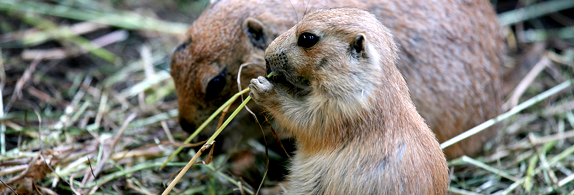
Prairie dogs have an odd image. Their little dog towns seem like barren mounds of holes in which to sprain your ankle or break a horse’s leg. They seem rat-like, if disarmingly sweet with their innocent faces and far off gazes. And they seem to be prey, as well, for sporting types with nothing better to do than kill little varmints.
It turns out, though, that prairie dogs have gotten a terribly inaccurate bad rap. They are one of the creatures, in their world usually far beyond our vision, that keeps life going. They are, in fact, what’s known as a keystone species, not merely a pest to be hunted by potshotters with a plunker’s lust for targets. Their own lives and habits make life possible for a vast ecosystem of other animals and plants.
According to Defenders of Wildlife, prairie dog “colonies create islands of habitat that benefit approximately 150 other species.” They are the food source for badgers, eagles, coyotes and for the endangered blackfooted ferret. Their burrows in the grass lands of the prairies and the West become homes for other critters, and they aerate and fertilize the soil and cause plant life to thrive.
Before the late l9th century there used to be more than a billion prairie dogs whose colonies covered over a 100 million acres. Defenders of Wildlife estimate that now their numbers have been reduced by 95 percent. Various Prairie Dog plagues, farmers plowing their colonies under, ranchers killing them off because they’re perceived as eating grass their cattle need for graze, have done the damage.
But as a keystone species they have an extra importance. Their absence tells us that the grassland upon which ranching and other forms of agriculture depend is not as healthy at its roots as it used to be when the Prairie Dogs were doing their job, and that other species are not doing as well either. Diversity in species spells health in the natural world, just as diversity in the social world of humans implies tolerance, humane values, and a flourishing culturally rich society.
There’s not much most of us can do directly to help the Prairie Dog, but we can agitate to keep prairie dog colonies protected on national grasslands across the Great Plains and, when the opportunity arises, financially support causes which protect them and speak up in their defense when they become objects of stereotypes and prejudices.
Much like the endangered silvery minnow in the Rio Grande, Prairie Dog health and habitat is an indication of the overall health of our landscape. The Silvery Minnow is dying out because the Rio Grande is becoming inhospitable to a large variety of life forms. Plains and grasslands with no prairie dogs are suffering the same fate – life is deserting them. And when that happens to plains and rivers, it’s not too far fetched to believe it’s starting to happen to us, as well.
(Photos: Steve Pearce by Gage Skidmore; Silver Leaf Nightshade by abbamouse; prairie dog by Kabacchi.)

October 14, 2013